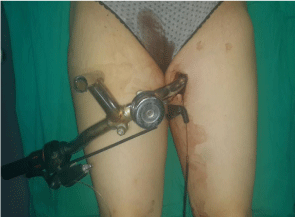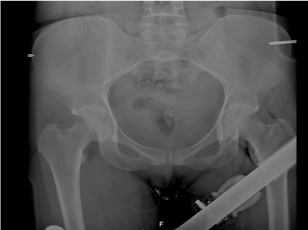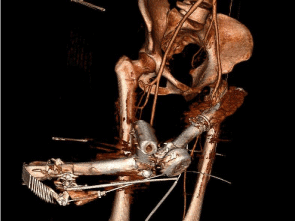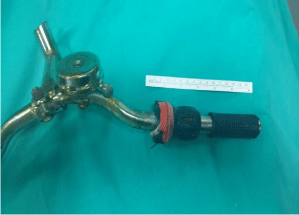
Case Presentation
Austin Orthop. 2017; 2(1): 1005.
Case Report of an Unusual Injury: The Removal of Bicycle Steering from Thigh
Kafadar IH*, Karaman I, Yazici A and Gunay AE
Department of Orthopedics and Travmatology, Medical Faculty, Erciyes University, Turkey
*Corresponding author: Kafadar IH, Department of Orthopedics and Travmatology, Medical Faculty, Erciyes University, Turkey
Received: July 01, 2017; Accepted: July 20, 2017; Published: July 27, 2017
Abstract
Foreign body penetration may occur in almost any part of the body. Bullet cores, needles, shrapnel pieces, glass-like objects can often be removed as foreign bodies from any part of the body; however bicycle steering removal has not been published before. Appropriate treatment after foreign body penetration includes tetanus prophylaxis, antibiotic treatment, removal of parts, and exploration for neurovascular injury, tissue repair, and debridement. In this unusual case report “a patient in which bicycle steering is stuck on her thigh after fall while riding on bicycle” is presented.
Keywords: Foreign Body; Bicycle Accident
Introduction
Foreign body injury can be seen in all of body parts. Foreign body injury was most frequently seen in the foot with needle, in young ages [1,2]. In addition eye, trachea and hands are other organs which encounter with foreign bodies frequently. Foreign bodies may be composed of different materials such as metal, glass, wood, plastic, etc [3,4]. Metalic bodies can be seen on X-ray easily, but diagnosis of wood and glass can be difficult.
Problems caused by foreign body penetration can be divided into two headings; as injury at the time of the incident, and complications in the later stages. Foreign body penetrations are usually cutting injuries (needle or glass). Low-energy injuries do not cause vascular, nerve or tendon injuries at subcutaneous level after passing the skin. However high-energy injuries due to firearm injuries and traffic accidents could be seen with neurovascular injuries or large bone fractures.
Foreign body penetration is seen as needle or glass penetration to the foot most frequently, but often does not cause additional injuries. Pseudomonas aeruginosa and Staphylococcus aureus infections may be seen, especially in diabetic patients [5]. For this reason, wide spectrum antibiotics should be added to the treatment, especially after firearm and other dirty injuries. Proper treatment in the case of multi-part foreign body injuries (bullshit, glass fragments) is to remove as many pieces as possible without damaging the integrity of the tissues [4].
Case Presentation
A 28-year-old female patient was taken to Erciyes University Medical Faculty Emergency Service because her bicycle steering was stuck in the left thigh (Figure 1). The blood pressure was measured as 130/80, pulse rate 95/minute, body temperature 36.5°C, blood glucose 98mg/dl at the initial evaluation. Tetanus prophylaxis was done, and gentamicin 1x160 mg and ampicillin-sulbactam 2g were given intravenously.

Figure 1: Bicycle steering stuck on anteromedial side of thigh.
On physical examination, the bicycle steering entered through the thigh anteromedially and proceeded between vastus medialis and rectus femoris. 20cm of the bicycle steering was inside the thigh, no exit hole was found. There was no active bleeding in the open wound. There was no deficiency in popliteal, tibialis posterior and dorsalis pedis pulses when compared to the right side. There was no motor or sensory deficit in the neurological examination of the left lower extremity. The fracture was not found on the radiography, but the object was found to have advanced from medial to the lateral side of femur (Figure 2).

Figure 2: Pelvis AP of the patient.
Computerized tomography angiography was taken for vascular injury. According to the examination, vascular structures were intact (Figure 3,4,5). The patient was operated under general anesthesia in the supine position. The entrance hole of the bicycle steering wheel was expanded with incisions made from the entrance to the distal and proximal. After vastus medialis muscle was loosened, the bicycle steering was slowly removed without damaging the surrounding tissues (Figure 6). The neurovascular structures were then explored. The exploration revealed that the femoral nerve, artery and vein were intact. The area where the foreign body was removed was abundantly washed with saline. The tissues that lost their integrity were debrided. Hemovac was placed and the skin closed.

Figure 3: 3D reconstructed view of computerized tomography.

Figure 4: 3D reconstructed view of computerized tomography (relation with
femoral artery and femur).

Figure 5: 3D reconstructed view of computerized tomography (relation with
femoral artery and femur).

Figure 6: Bicycle steering after removal.
After the operation, the patient was followed up for 3 days with intravenous antibiotics and daily wound care. The patient started to walk on the first day after the operation and discharged at the third day. The sutures of the patient were taken in the 3rd week, and suggested to return daily activities.
Conclusion
Foreign body injury could be seen in all of body parts. Foreign body injury was most frequently seen in the foot with needle, especially in young ages. Foreign objects can be materials like metal, glass, wood, or plastic. Foreign body penetration to thigh is rare but neurovascular injuries can occur in these patients. The femoral artery and vein, femoral nerve, sciatic nerve may be damaged during injury of this region and during the foreign body removal. However it was presented that a case in which the bamboo branch penetration to the posterior of thigh during skiing did not cause an additional organ injury [5].
In this case presentation, we removed the foreign body with preserving neurovascular structures, cleaned the wound, and applied systemic antibiotics after operation to prevent infection. Once the foreign body has been removed, debridement and washing should be applied to remove small parts of the foreign body. Only the area where the foreign body was stuck was explored carefully by preserving neurovascular bundle. In order to see that the neurovascular structures were intact, explorations were made to the region from which the foreign body was removed and it was seen that the neurovascular structures were intact. If we were faced with a more complicated case, cardiovascular and orthopedic surgeon could work together. Moreover, the patient could have had a femur fracture. This condition also could make the case more complicated.
Result
Treatment and follow-up of such a case requires carefully removal of foreign body in the first instance, and cleaning and washing the area where foreign body located, and applying systemic antibiotics after the operation.
References
- Salati SA, Rather A. Missed foreign bodies in the hand: an experience from a center in Kashmir. Libyan J Med. 2010.
- Nagendran T. Management of foreign bodies in the emergency department. Hospital Physician. 1999: 9; 27-40.
- Hunter TB, Taljanovic MS. Foreign bodies. Radiographics. 2003; 23: 731- 757.
- Rubin G, Chezar A, Raz R, Rozen N. Nail puncture wound through a rubbersoled shoe: a retrospective study of 96 adult patients. J Foot Ankle Surg. 2010; 49: 421-425.
- Yang I, Hayes CW, Jacobson JA, Jamadar DA, Wang S. Unique foreign body injury: bamboo penetration of thigh and pelvis while skiing. Emerg Radiol. 2002; 9: 243-246.